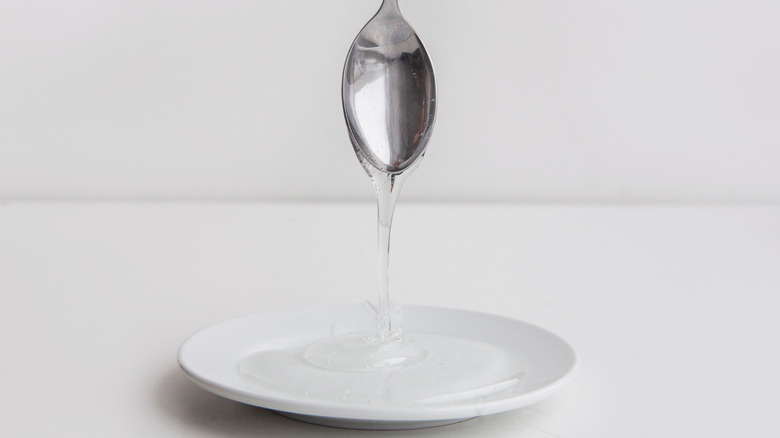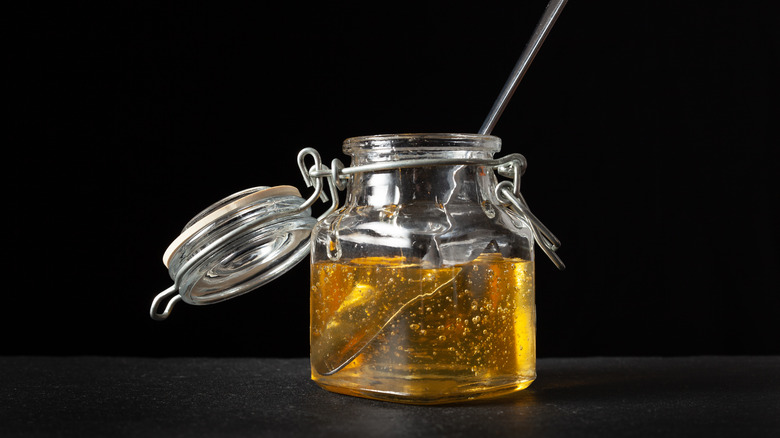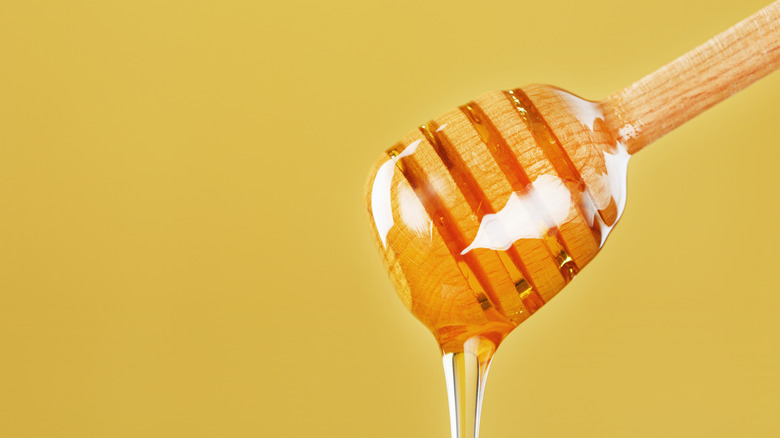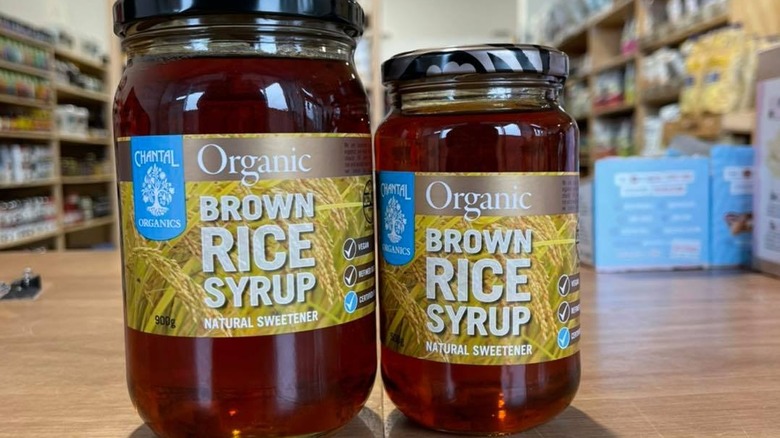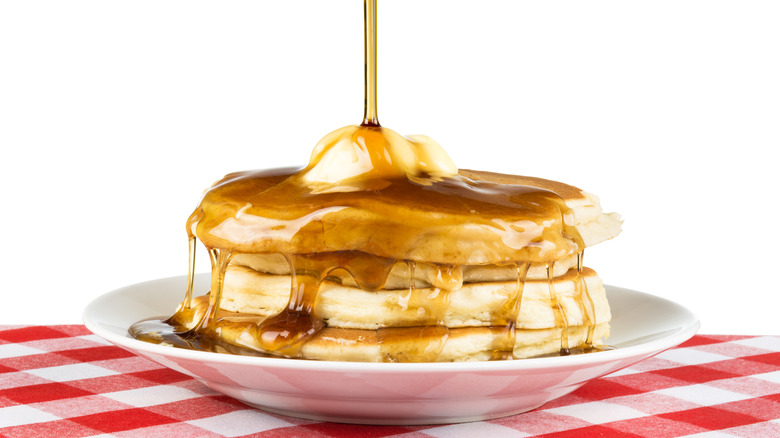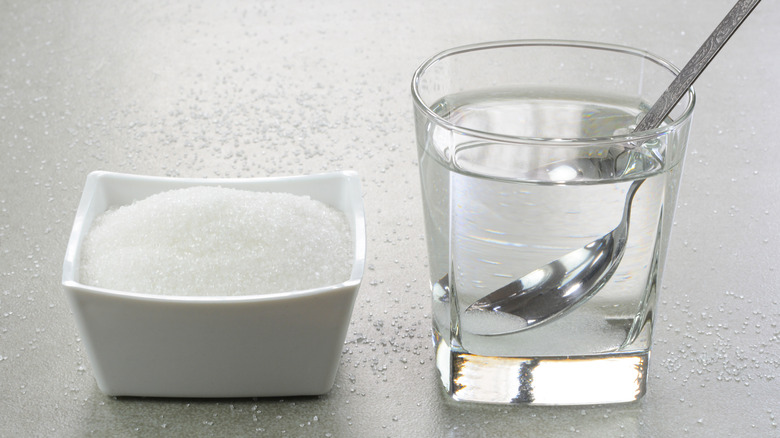5 Easy Ingredient Swaps For Corn Syrup In A Recipe
Corn syrup is an extremely useful ingredient for all things sweet. To be clear, we're talking about the pure stuff, which is different from high-fructose corn syrup, the widely maligned ingredient that's been causing a stir amongst nutritionists for decades. Corn syrup is made from the sugars naturally present in cornstarch, and its role in baked goods and candies is often misunderstood. Yes, it provides sweetness, but that isn't its most important characteristic.
Corn syrup is only about half as sweet as granulated sugar, and you'll rarely see it used as the sole sweetener in a recipe. Instead, it is typically paired with granulated sugar. Its main purpose is textural: it prevents the sugar in a recipe from crystalizing, ensuring uniformity. Corn syrup plays an essential role in the smoothness of candies, jams, ice creams, and sweet pies like pecan pie. If you don't have it on hand, you can't simply omit it from your recipes. You'll need to find an ingredient to swap in its place.
To find good substitutes for corn syrup, it helps to use the Brix scale, which measures the amount of sugar in a particular liquid. The higher an ingredient's Brix degree, the sweeter it is. Corn syrup typically sits around 77 degrees Brix, so you'll need something in that range. Fortunately, there are plenty of options that fit the bill. The right choice will depend on what recipe you're trying to make.
Agave nectar is the easiest swap
Agave is best known as the plant that tequila and mezcal are made from, but it's also popular as a sweetener. Its nectar, also known as agave syrup, is the succulent's concentrated sap, and it happens to be a pretty ideal one-to-one substitute for corn syrup in many cases. It ranges from around 65 to 79 degrees Brix, which puts it right about on par with corn syrup. Most crucially, agave nectar has a very mild flavor, just like corn syrup, so you shouldn't perceive any difference in the way your food tastes.
In addition to matching the sweetness and flavor of corn syrup, agave nectar has a similar viscosity. Both are thick, yet easily pourable. This makes agave nectar a great substitute for corn syrup in ice creams, sweet sauces, and sugar pies. The one drawback to agave nectar is that you cannot use it in place of corn syrup in candy recipes. Agave nectar has different chemical properties from corn syrup, and it will burn before it reaches the necessary temperature for candy-making.
Honey is a slightly sweeter substitution
Although agave nectar is the most accurate swap for corn syrup in most instances, it's still growing in popularity, and may not be considered a pantry staple for many home cooks just yet. One thing that is a pantry staple in most U.S. homes, however, is honey, and it also makes a great one-to-one substitute for corn syrup, albeit with a few considerations. Honey comes in around 80 degrees Brix, a few notches higher than most corn syrup, so bear in mind that using this swap could make your food turn out sweeter. That will partially depend on the type of honey you use, which brings up another issue.
There are a vast number of honey varieties, differentiated by which plants the bees get their nectar from. The source of the nectar has a dramatic impact on color, sweetness, and overall flavor. If you are using honey as a corn syrup substitute, you want to use the mildest variety possible to most closely match the nearly neutral flavor of corn syrup. Clover honey is a great choice here because it is light and mild, as is alfalfa honey. On the other hand, darker varieties like buckwheat honey can overwhelm the other flavors in your recipe. Honey works best in baked goods and beverages, but it won't work for candy because it crystallizes easily.
Brown rice syrup is the swap you need for candy
Candy recipes are by far the most difficult cases to swap corn syrup for. There just aren't many liquid sweeteners that can reach the temperatures required for making candy and prevent crystallization at the same time. Brown rice syrup is the exception. Also known as rice malt syrup or maltose syrup, it is thick and sticky like molasses, but lightly-colored like honey. It is made by converting rice starch into sugar and concentrating it into a syrup.
Brown rice syrup perfectly matches the sweetness of corn syrup. It comes in at 78 degrees Brix, right on par with corn syrup's 77 degree average. Brown rice syrup is versatile enough to be used in practically any recipe that calls for corn syrup, including baked goods, marshmallows, and most importantly, candy. Brown rice syrup can withstand the heat necessary to make hard candies and it effectively prevents that pesky crystallization problem.
Pancake syrup beats maple syrup
Maple syrup is an acceptable corn syrup substitute if you don't have anything else on hand, but it has a much runnier consistency and a very different flavor, so it should really be kept as a last resort in baked goods (or better yet, use maple syrup as a vanilla substitute). You would be much better off using artificial maple syrup, commonly known as pancake syrup, as a one-to-one substitute for corn syrup. The reason that pancake syrups like Mrs. Butterworth's and Log Cabin work so well in place of corn syrup is the fact that, for the most part, they are corn syrup.
Most brands of pancake syrup are made with a combination of corn syrup and high fructose corn syrup as the two primary ingredients. Thus, pancake syrup has the same consistency as corn syrup. However, pancake syrups do contain artificial maple flavoring, which makes them taste much stronger than the comparatively mild corn syrup. It is best used in recipes that complement a maple flavor, like baked goods.
Simple syrup has the most versatile flavor, but takes more work
This last option requires more effort than the others, but it gives you a light, mild syrup that comes about as close to the flavor of corn syrup as you can get. Simple syrup is aptly named, as all you need to make it is sugar and water, which you boil together until all the sugar dissolves. A standard simple syrup recipe, typically used for cocktails, calls for equal parts sugar and water, but this will leave you with a pretty thin consistency. To match the viscosity of corn syrup, you'll need to add more sugar to the mix.
The best ratio to use for a corn syrup substitute is four parts sugar to one part water. This will make the syrup thicker, and bring the sweetness level up to around 80 degrees Brix, making it even a bit sweeter than corn syrup. Despite this, simple syrup's neutral flavor means you can swap it in place of corn syrup in nearly any recipe that calls for it without having to worry about changing the flavor or texture. The one exception, as with most corn syrup substitutes, is that simple syrup won't work for candy. It is, after all, made from granulated sugar, so it will crystallize if you attempt to make candy with it.
